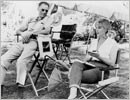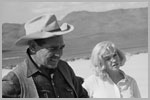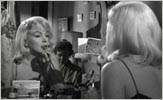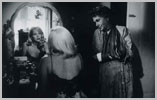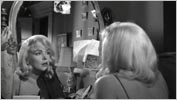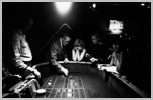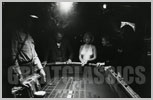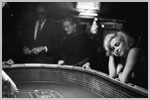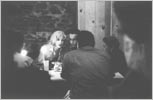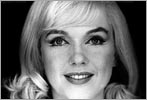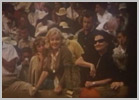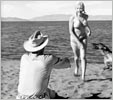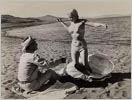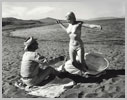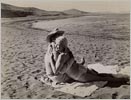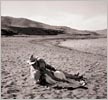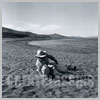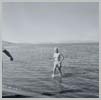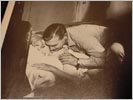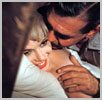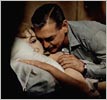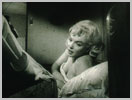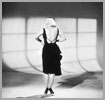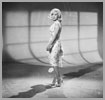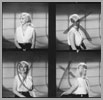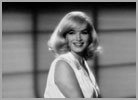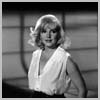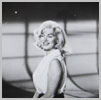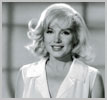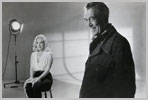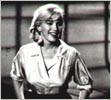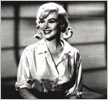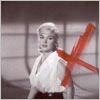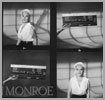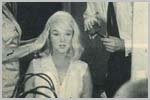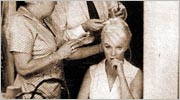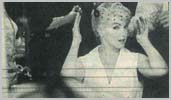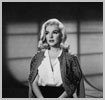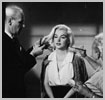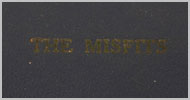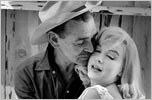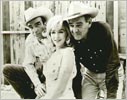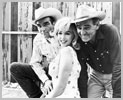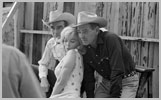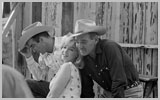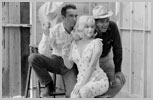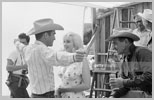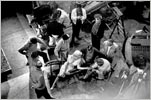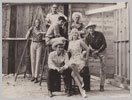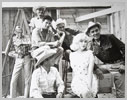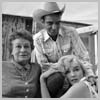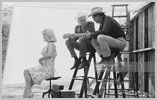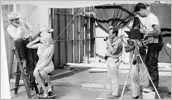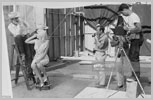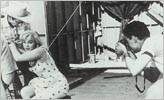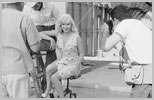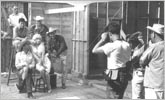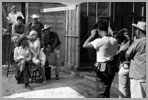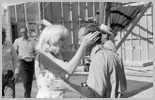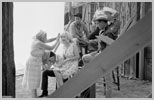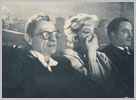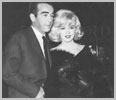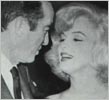
My journey ends here...
The Misfits (1961)
 ,
, ,
, ,
,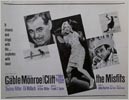 ,
,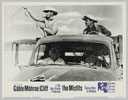 ,
, ;
;
"The Misfits" is Marilyn's 29th and last movie, without considering "Something's Got to Give", unfinished.
Arthur Miller had written a short story, puiblished in Esquire magazine in 1957. When he lived in Reno, waiting for his divorce and before marrying Marilyn, he had met some men who, like Clark Gable and Montgomery Clift in the movie, captured wild horses they sold back after, and from which was made food for animals.
Miller adapted the short story to make it a screenplay, Sam Shaw having suggested him that the subject would make an excellent movie for Marilyn. For that, Miller had to develop Roslyn's character, too dweeb for the short story.
He worked again in the screenplay until the last day of shooting. He always modified the end and found it difficult to decide which cow-boy would win the young woman's heart.
Montgomery Clift was not the only one to think that Clark Gable, who was a mature man, had to get the leading role.
At the beginning of 1958, Miller suggested the production of the movie to his friend Frank Taylor, who suggested to send the screenplay to John Huston and to propose him the direction.A prestigious team was gathered, including Montgomery Clift and Eli Wallach, both Marilyn's friends. But Miller did better and managed to convince Clark Gable, explaining him that it was "kind of an East western which dealt with the lack of meaning in our lives and also maybe the way we have arrived where we are".
At the beginning, Marilyn considered the movie as a love gift. But when the shooting began, the relations between her and Miller had reached their breaking point.
In his autobiography, Arthur Miller wrote :
"Since the beginning of the "The Misfits", it was
impossible for me to deny that , if there was a key for Marilyn's
despair, I didn't own it".
Strikes among the actors and writers, at the beginning of 1960, had delayed the shooting of Marilyn's previous movie, "Let's Make Love"
(1960).
The outdoor scenes of the "The Misfits", in the Nevada desert, could only start mid-July. There were more than 30° C.
The movie was more reputed for the tension which reigned on the set
than for the final result, a real drama performance. The atmosphere was
full of Marilyn's hostility towards Miller, the arguments between John
Huston and Paula Strasberg
and many other anger demontrations. Marilyn and Miller argued in
public and in private during the first half of the shooting, until
Marilyn left the suite they shared to settled at Paula Strasberg's
place.
Miller constantly re wrote the dialogues and stayed up late at night. The next day, he reviewed the text with Huston at the hotel and on the set. Marilyn found it difficult to remember the lines, and the constant changes made her things more difficult.
Marilyn's lack of punctuality, her illnesses, her incoherent condition after massive barbiturates administration to sleep, her arguments with Miller made the shooting long and difficult. As time goes by, she arrived more and more lmate and when she finally arrived, she didn't listen Huston and Miller, but only Paula Strasberg.
At the end of August, Huston sent Marilyn to Los Angeles for 10 days, either to undergo detoxification, or to treat a nervous breakdown, according to the versions.
Ernst Haas, one of the photographers of the Magnum Agency, made the following comment : "All those who were on the set were misfits - Marilyn, Monty, John Huston, always on the berge of panic. And Gable didn't say much, he was just Gable".
The post-production work was speeded up so that
the movie would be ready for the Academy Awards nominations. But it
didn't obtain any, even posthumous for Clark Gable. The movie had cost
4 million $, which, in 1961, made it the black and white movie the most expensive.
At the end of the shooting, Marilyn announced her separation from Miller. Later he would say : 'The movie had been a torture for her... Today I marvels at the measure of what she had done in the circumstances she had done it"'.
Miller then married Inge Morath, the photographer of the Magnum agency he had met on the set.
The premiere took place on January 31, 1961, to honor Clark Gable's memory who died less than 2 weeks after the end of the shooting. 11 days after her divorce, she was accompanied with Montgomery Clift at the reception which took place at the Capitol Theater, on Broadway and 51st Street.
In her last interview to reporter Richard Meryman, for Life magazine, she talks about the difficulties on the set.
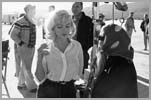 ,
, ,
, (mors pics here).
(mors pics here).
Negligee
John Huston and Kay Gable's birthday party August 5, 1960
 ,
, ,
,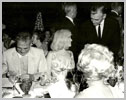 ,
,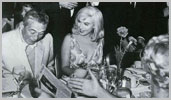 (more pics here).
(more pics here).
Off set
Casino
John Huston and Arthur Miller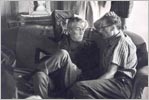 ;
;
Bathsuit
Bathrobe
 ,
, ,
, ,
, (more pics here).
(more pics here).
Cherry dress
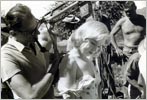 ,
, ,
, ,
, ,
, ,
,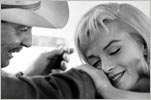 ,
, (more pics here).
(more pics here).
Black dress
 ,
, ,
, ,
, (more pics here).
(more pics here).
Black dress and veil hat
 ,
, ,
, ,
, (more pics here).
(more pics here).
Bed scene
with Clark Gable
Denim jacket
 ,
,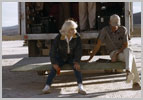 ,
,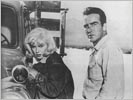 ,
, ,
, (more pics here).
(more pics here).
Striped blouse
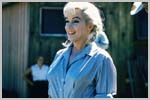 ;
;
Wardrobe tests
pictures
sketch ,
, ,
, ,
, ,
,
Hairdressing

Production call sheet dated October 18, 1960 
Publicity pictures
with Clark Gable
with Clark Gable and Montgomery Cliftwith the crew
during the shooting
The premiere of the movie took place on January 31, 1961 at the New York Capitol Theatre
with Montgomery Clift
alone ,
, ,
, ,
,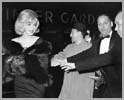 -
-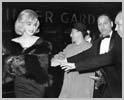
Also see Eve Arnold's pictures during the shooting.
CREDIT
United Artists/Seven Arts Production, black and white
Runtime : 124 mnRelease date : February 1, 1961.
Director : John Huston
Producer : Frank E. Taylor
Screenplay : Arthur Miller
Director of photography : Russell Metty ( ;
; )
)
Music :
Alex North
Production
: Frank R. McKelvy
Film editing: George Tomasini.
CAST
Clark Gable
- Gay Langland
Marilyn
Monroe - Roslyn Taber
Montgomery Clift - Perce Howland
Thelma
Ritter - Isabelle Steers
Eli Wallach - Guido
James Barton - Fletcher's grandfather
Estelle Winwood - church lady collecting money in bar
Kevin
McCarthy - Raymond Taber
Dennis Shaw
- Fletcher, young boy in bar
Philip
Mitchell - Charles Steers
Walter Ramage - old groom
J. Lewis
Smith - fresh cowboy in bar
Marietta
Tree - Susan
Bobby
LaSalle - bartender
Ryall Bowker - man in bar
Ralph Roberts -ambulance driver at rodeo
Peggy Barton - young bride.
TECHNICAL CREW
Stephen B. Grimes - art director
William Newberry - art director
Lew Smith - coach for talks
Allan "Whitey" Snyder - make-up
Agnes Flanagan - hairdresser
Sidney Guilaroff - hairdresser
Frank La Rue - make-up
Frank Prehoda - make-up
Frank McKelvy - set decorator
C.O. Erickson - director of production
Carl Beringer - assistant director
Charles Grenzbach - sound recordist
Philip Mitchell - sound recordist
Chuck Robertson - stunts (uncredited)
Angela Allen - script supervisor
Billy Jones - wrangler
Jean-Louis - costumes of Mrs Monroe
Edward Parone - assistant to producer
Tom Shaw - second unit director
Lew Smith - coach for dialogues (uncredited)
Paula Strasberg - coach Mrs Monroe (uncredited)
Rex Wimpy - photographer.
SYNOPSIS
Roslyn Tabor (Marilyn Monroe) is in Reno to divorce from her husband, Raymond (Kevin McCarthy).
The homeowner of her house, Isabelle
Steers (Thelma Ritter), introduces her to Guido (Eli Wallach),
desperate since his wife's death. Guido introduces Roslyn to
a cow-boy, Gay Langland (Clark
Gable), with who she falls in love.
Langland planned an outing in the hills to catch wild horses. He hired Guido and Perce Howland (Montgomery Clift), a regular of rodeos.
Roslyn accompanied the three men, but learn that Langland planned to sell the horses which would be transformed into dog food.
He's deaf to his protests, but she manages to convince to release the animals. Langland is furious and is in pursuit of the head stallion of the herd at the cost of significant physical efforts. But, as soon as he has caught it, he releases it.
The three men split up. Langland and Roslyn leave together by car, and it's understood that they intend to live together.BIBLIOGRAPHY
"The Story of the Misfits". James Goode, Indianapolis, Bobbs-Merill, 1963.
New publication in 1986 under the title of "The Making of the Misfits". A daily report of the shooting of "The Misfits".
